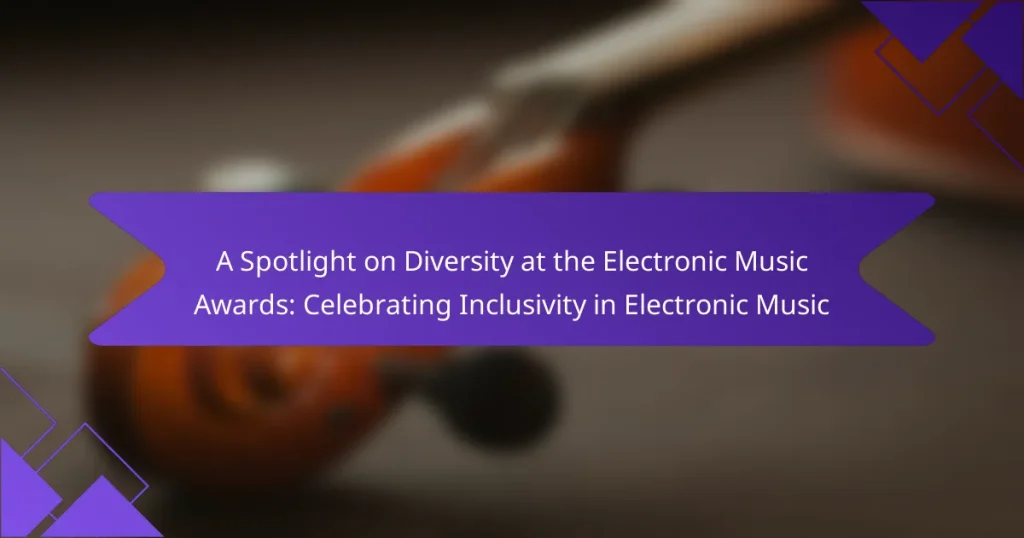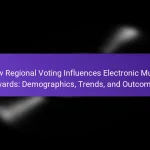The Electronic Music Awards play a crucial role in promoting diversity and inclusivity within the electronic music community. By highlighting artists from various backgrounds, including different genders, races, and cultures, the awards enhance representation and foster innovation in the genre. Initiatives such as mentorship programs and panels focused on diversity aim to create a more equitable environment within the industry. Celebrating a diverse range of voices not only enriches the music scene but also attracts larger audiences, ultimately strengthening the cultural impact of electronic music.
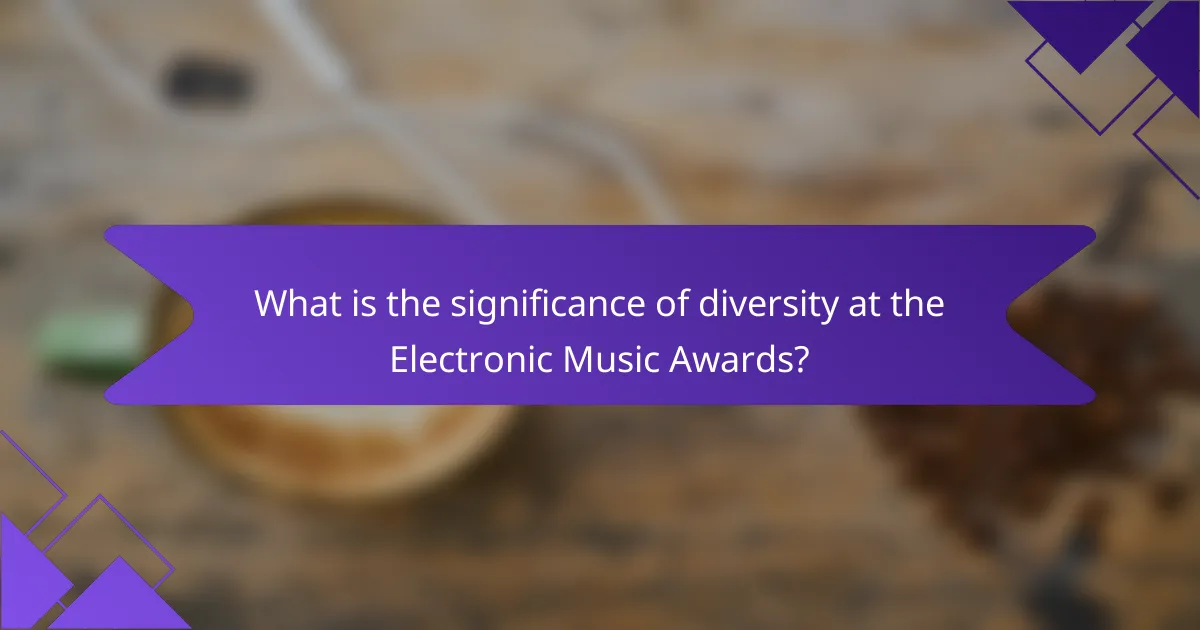
What is the significance of diversity at the Electronic Music Awards?
Diversity at the Electronic Music Awards is significant because it promotes inclusivity within the electronic music community. This inclusivity allows for a wider range of voices and perspectives to be recognized and celebrated. The awards aim to highlight artists from different backgrounds, ensuring representation across gender, race, and culture. By celebrating diversity, the Electronic Music Awards foster innovation and creativity in the genre. This approach not only enriches the music itself but also reflects the global nature of electronic music. Statistics show that diverse lineups attract larger audiences and enhance the overall experience. Inclusivity at the awards encourages emerging artists to participate and gain visibility. Ultimately, diversity strengthens the electronic music scene and its cultural impact.
How does diversity enhance the electronic music scene?
Diversity enhances the electronic music scene by introducing a variety of cultural influences. This leads to innovative sounds and unique musical styles. Different backgrounds contribute to the richness of genres like techno, house, and drum and bass. Artists from diverse communities bring fresh perspectives and creativity to their work. Collaborative projects often result in genre-blending, which attracts wider audiences. For instance, the fusion of African rhythms with electronic beats has gained popularity globally. Festivals celebrating diversity showcase a broader range of talent, promoting inclusivity. This inclusivity encourages more artists to participate in the scene, further enriching its vibrancy.
What are the key elements of diversity in electronic music?
Key elements of diversity in electronic music include genre variety, cultural influences, and representation. Genre variety encompasses styles such as techno, house, drum and bass, and ambient. Cultural influences originate from global traditions, incorporating sounds from Africa, Asia, and Latin America. Representation focuses on inclusivity of gender, ethnicity, and [censured] orientation among artists and audiences. The electronic music scene has seen a rise in female producers and DJs, contributing to gender diversity. Events like the Electronic Music Awards highlight these diverse voices and promote inclusivity. Studies show that diverse lineups enhance audience engagement and broaden musical experiences.
How does diversity influence the creativity of artists?
Diversity enhances the creativity of artists by introducing varied perspectives and experiences. This variety fosters innovation and leads to unique artistic expressions. Artists from different backgrounds bring distinct cultural influences to their work. Research shows that diverse teams generate more creative solutions compared to homogenous groups. For example, a study by Harvard Business Review found that diverse teams are 35% more likely to outperform their counterparts. This blend of ideas results in richer, more complex art forms. Consequently, inclusivity in artistic communities drives the evolution of styles and genres.
Why is inclusivity important in the electronic music community?
Inclusivity is important in the electronic music community because it fosters creativity and innovation. A diverse range of voices contributes to unique sounds and styles. This variety enriches the overall experience for artists and audiences alike. Additionally, inclusivity promotes a sense of belonging among participants. It encourages collaboration across different backgrounds. Studies show that diverse teams are more effective in problem-solving and creativity. By embracing inclusivity, the electronic music community can reach broader audiences. This leads to increased attendance at events and higher engagement with music. Ultimately, inclusivity strengthens the community and its impact on culture.
What challenges do underrepresented groups face in electronic music?
Underrepresented groups in electronic music face significant barriers to entry and recognition. These challenges include limited access to resources, industry connections, and platforms for exposure. Historical biases have often marginalized these groups in mainstream electronic music scenes. According to a 2021 report by the Association for Electronic Music, only 16% of electronic music artists identify as women, highlighting gender disparity. Additionally, racial and ethnic minorities often encounter systemic discrimination within the industry. This lack of representation can lead to fewer opportunities for collaboration and performance. Furthermore, financial constraints often hinder access to music production education and technology. Overall, these challenges contribute to a cycle of underrepresentation in the electronic music landscape.
How can inclusivity lead to a more vibrant music culture?
Inclusivity fosters a more vibrant music culture by broadening participation and creativity. Diverse voices contribute unique perspectives and styles. This variety enriches the music landscape, attracting wider audiences. Statistics show that diverse lineups at festivals lead to increased attendance and engagement. For example, events featuring a mix of artists from different backgrounds often see higher ticket sales. Inclusivity also encourages collaboration among artists, resulting in innovative genres and sounds. When all individuals feel represented, they are more likely to engage with and support the music community. This engagement creates a dynamic ecosystem that continually evolves and thrives.
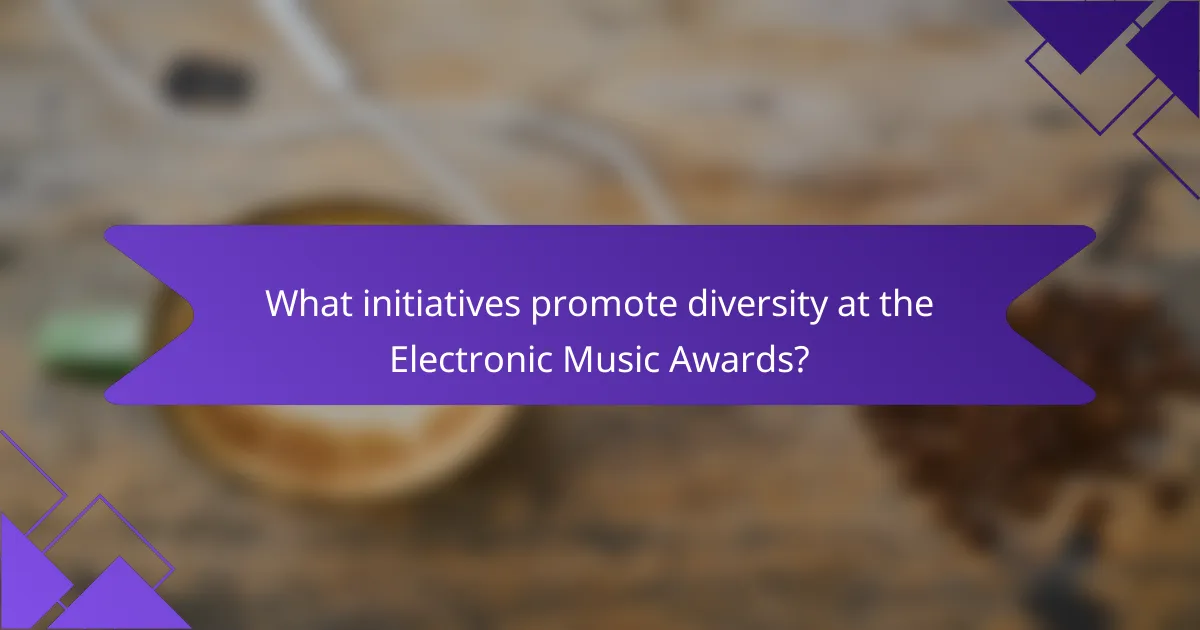
What initiatives promote diversity at the Electronic Music Awards?
The Electronic Music Awards promotes diversity through various initiatives. They prioritize inclusive representation in nominations and awards. The organization actively seeks to recognize artists from diverse backgrounds. They also implement mentorship programs for underrepresented groups in the electronic music scene. Additionally, they host panels and discussions focused on diversity and inclusion. These efforts aim to foster a more equitable environment within the industry. The commitment to diversity is reflected in their partnerships with organizations that support marginalized communities.
How are awards categories designed to reflect diversity?
Awards categories are designed to reflect diversity by incorporating various demographic and cultural factors. This includes recognizing artists from different ethnic backgrounds, genders, and [censured] orientations. Additionally, categories may focus on specific genres that celebrate underrepresented communities. The inclusion of diverse judges and voters also ensures a broad perspective in the selection process. Historical data shows that awards with diverse categories increase representation and visibility in the industry. For instance, the Grammy Awards introduced gender-neutral categories to promote inclusivity. Such measures highlight the commitment to recognizing the contributions of all artists in the electronic music scene.
What specific awards highlight contributions from diverse artists?
The specific awards that highlight contributions from diverse artists include the Grammy Awards, the NAACP Image Awards, and the Brit Awards. The Grammy Awards recognize outstanding achievements in the music industry, including categories for various genres and artists from different backgrounds. The NAACP Image Awards celebrate the accomplishments of people of color in the arts, including music. The Brit Awards also feature categories that honor diverse contributions in the UK music scene. These awards serve as platforms to acknowledge and promote inclusivity among artists from various cultural and ethnic backgrounds.
How do nominations and voting processes support inclusivity?
Nominations and voting processes support inclusivity by providing equal opportunities for diverse voices. These processes allow individuals from various backgrounds to be recognized and participate. By implementing transparent criteria, organizations can ensure fair representation. This approach encourages a broader range of nominees. Data shows that diverse panels lead to more inclusive outcomes. For example, research indicates that organizations with diverse leadership make better decisions. Thus, inclusivity in nominations and voting fosters a richer cultural landscape.
What collaborations exist to foster diversity in electronic music?
Collaborations that foster diversity in electronic music include initiatives like the “Women in Electronic Music” project. This project highlights female producers and DJs, providing them a platform to showcase their work. Another collaboration is “Black Artist Database,” which promotes Black artists in the electronic scene. These efforts aim to increase representation and visibility. Additionally, organizations like “Sister System” focus on supporting marginalized communities in music. These collaborations help create a more inclusive environment in electronic music.
How do partnerships with organizations promote inclusivity?
Partnerships with organizations promote inclusivity by combining resources and expertise to create diverse environments. Collaborative efforts increase access to underrepresented groups. This can lead to more equitable opportunities in various sectors. For example, initiatives may focus on mentorship programs for marginalized communities. Research shows that diverse teams outperform homogeneous ones. A study by McKinsey found that companies with diverse workforces are 35% more likely to have financial returns above their respective national industry medians. Furthermore, partnerships can facilitate cultural exchange and understanding. This fosters a sense of belonging and acceptance among different communities.
What role do mentorship programs play in supporting diverse talent?
Mentorship programs play a crucial role in supporting diverse talent by providing guidance and resources. They facilitate networking opportunities for individuals from underrepresented backgrounds. These programs help mentees develop skills and confidence in their respective fields. Research indicates that mentorship can significantly improve career advancement for diverse individuals. According to a study by the American Psychological Association, mentees are more likely to receive promotions and raises. Furthermore, mentorship fosters a sense of belonging and community among diverse talent. This support encourages creative expression and innovation in the electronic music industry. Overall, mentorship programs are essential for nurturing diverse talent and promoting inclusivity.
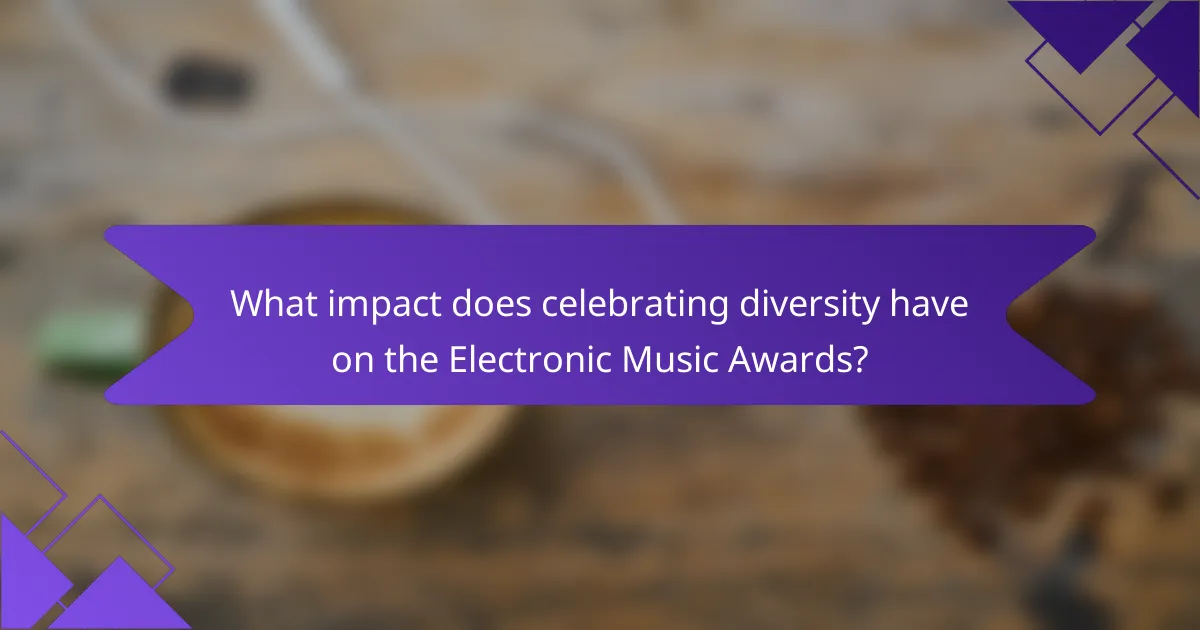
What impact does celebrating diversity have on the Electronic Music Awards?
Celebrating diversity positively impacts the Electronic Music Awards by fostering inclusivity. This inclusivity encourages a broader range of artists to participate. A diverse lineup attracts a wider audience, enhancing engagement. Celebrating various cultures and backgrounds enriches the music scene. It also promotes innovation through the blending of different styles. Research shows that diversity in music leads to increased creativity and collaboration. The Electronic Music Awards, by embracing diversity, set a standard for the industry. This commitment to diversity can drive social change within the music community.
How does diversity recognition influence audience engagement?
Diversity recognition significantly enhances audience engagement. It fosters a sense of belonging among diverse groups. When audiences see representation, they feel valued and included. This connection can lead to increased participation in events. Studies show that diverse representation can boost attendance by up to 30%. Furthermore, inclusive messaging resonates more with varied demographics. Brands that embrace diversity often experience higher loyalty rates. Engaging diverse audiences can also lead to richer content creation. Overall, recognizing diversity is key to building strong audience relationships.
What feedback have attendees provided regarding diversity initiatives?
Attendees have provided positive feedback regarding diversity initiatives at the Electronic Music Awards. Many participants expressed appreciation for the inclusive programming and representation. They noted that diverse speakers and performers enhanced the event’s appeal. Attendees highlighted the importance of visibility for underrepresented groups in the electronic music scene. Feedback indicated that initiatives fostered a sense of community and belonging. Some participants suggested more opportunities for collaboration among diverse artists. Overall, the response emphasized the need for ongoing commitment to diversity in future events.
How does media coverage shape perceptions of diversity at the awards?
Media coverage significantly shapes perceptions of diversity at awards. It influences public opinion and highlights representation. Positive media narratives can enhance visibility for underrepresented groups. Conversely, negative coverage may perpetuate stereotypes or overlook diversity efforts. Studies show that diverse representation in media correlates with increased audience engagement. For example, awards that celebrate inclusivity often receive more favorable media attention. This attention can lead to greater awareness and appreciation of diversity within the industry. Thus, media acts as a powerful tool in framing the narrative around diversity at awards.
What are the future trends for diversity in electronic music events?
Future trends for diversity in electronic music events include increased representation of women and marginalized communities. Events are likely to feature lineups that prioritize diverse artists. This shift aims to create a more inclusive atmosphere. Research shows that diverse lineups enhance audience engagement and satisfaction. Festivals are beginning to implement diversity quotas for artists. Initiatives promoting underrepresented genres are also on the rise. Collaboration with organizations focused on diversity will likely become standard practice. Overall, these trends reflect a growing commitment to inclusivity in the electronic music scene.
How can technology enhance diversity at future awards?
Technology can enhance diversity at future awards by utilizing data analytics to identify underrepresented groups. This approach enables organizers to recognize trends and demographic gaps in nominations and winners. Additionally, virtual platforms can facilitate global participation, allowing diverse voices from different regions to engage. Social media tools can amplify outreach efforts to marginalized communities, ensuring broader representation. Moreover, AI-driven tools can assist in creating fair judging processes by anonymizing submissions. These methods have been proven to increase diversity in various sectors, as seen in initiatives like the Grammys’ diversity task force.
What steps can be taken to ensure sustained inclusivity in the industry?
Implementing sustained inclusivity in the industry requires a multi-faceted approach. First, organizations should establish clear diversity and inclusion goals. These goals should be measurable and publicly reported to ensure accountability. Second, training programs on unconscious bias and cultural competency must be mandatory for all employees. Research shows that such training can significantly improve workplace inclusivity. Third, creating diverse hiring practices is essential. This includes outreach to underrepresented communities and partnerships with organizations that support diversity. Fourth, providing mentorship programs can help support the growth of diverse talent within the industry. Studies indicate that mentorship can enhance career advancement opportunities for underrepresented groups. Lastly, fostering an inclusive culture through regular feedback and open communication encourages diverse voices to be heard. This holistic approach can lead to a more inclusive environment in the electronic music industry.
What practical tips can artists and organizers implement to promote diversity?
Artists and organizers can promote diversity by actively including underrepresented groups in their events. They should prioritize diverse lineups that feature artists from various backgrounds. Collaborating with community organizations can help reach diverse talent pools. Offering mentorship programs for emerging artists from marginalized communities fosters inclusivity. Providing platforms for diverse voices in decision-making processes ensures representation. Implementing accessibility measures makes events welcoming for all. Engaging in outreach efforts to educate audiences about diversity enhances awareness. Regularly assessing diversity initiatives can help identify areas for improvement.
The main entity of the article is the Electronic Music Awards, which focuses on celebrating diversity and inclusivity within the electronic music community. The article highlights the significance of diversity, discussing its impact on creativity, audience engagement, and representation across gender, race, and culture. Key elements include initiatives that promote underrepresented artists, the importance of mentorship programs, and the challenges faced by marginalized groups in the industry. Additionally, the article examines future trends and practical steps for sustaining inclusivity in electronic music events.
